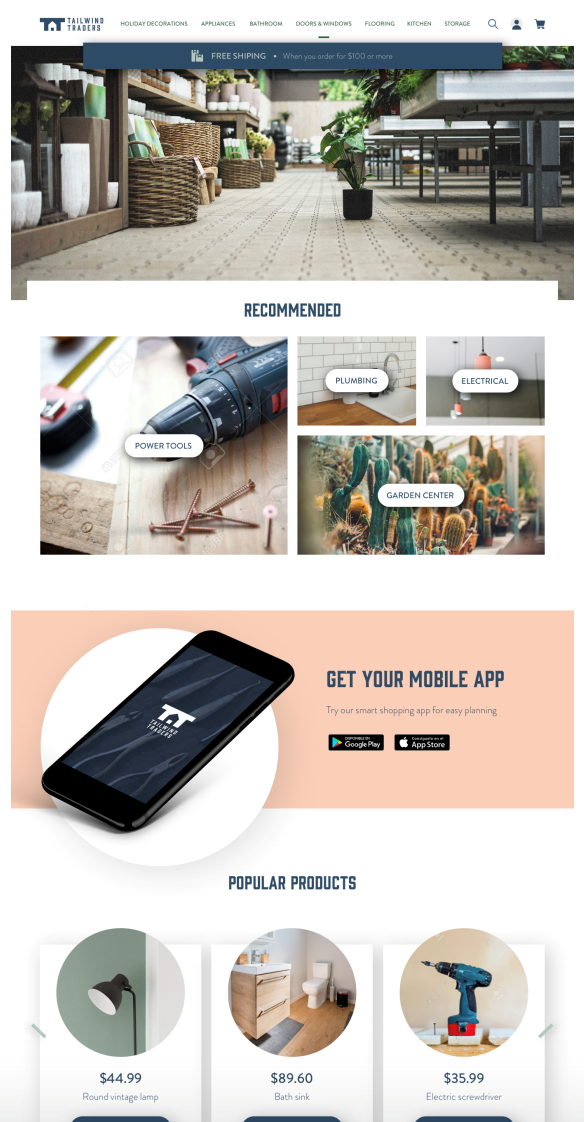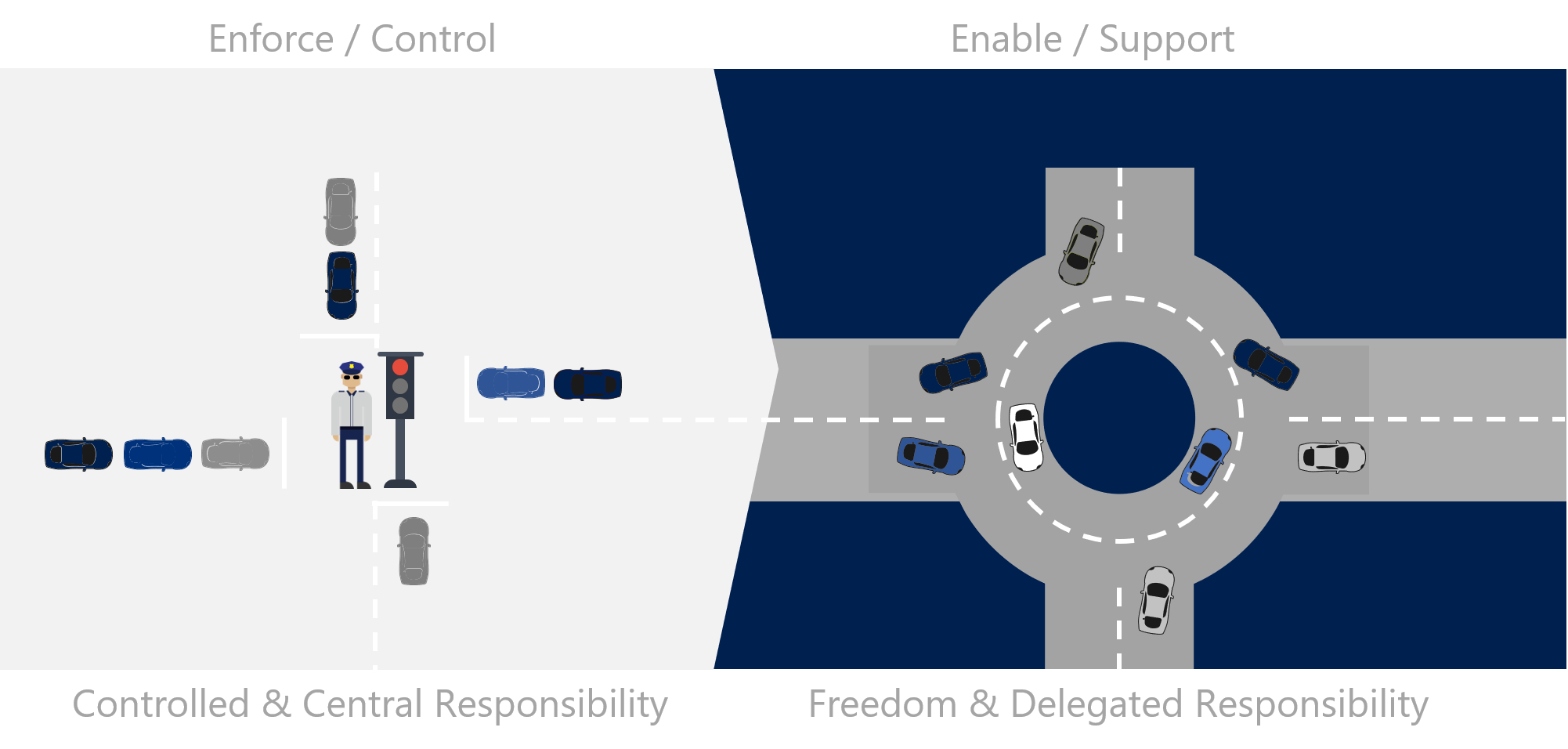Customer narrative

Figure 1: The Tailwind Traders logo.
Tailwind Traders is a modern commerce company. For more than 30 years, the company has been a popular retail destination. It has grown to more than 50 physical stores. Several years ago, its Chief Executive Officer (CEO) anticipated changes in retail and bought a competing e-commerce startup that was growing aggressively in niche markets. Today, the company is seen as an innovative leader with customer-focused local storefronts.
Retail innovation
The Tailwind Traders retail innovation team uses technology to continually redefine the company's position as a leader in modern commerce.

Figure 2: The website and application that started the retail innovation efforts.
The retail innovation team reports to the company's Chief Technology Officer (CTO), who was the CEO of the acquired e-commerce startup. Those technology solutions are the main hub for interactions with customers. Those solutions affect 60 percent of global revenue and produce 30 percent of annual gross sales. Examples of those innovations include:
- Boundless commerce: Originally a simple e-commerce solution, this custom-built platform now provides online and offline experiences for customers. Customers can make purchases from the platform, and the mobile app gathers information from customers' viewing history to customize the retail experience with in-store ads, shopping lists, and other interactions.
- Analytics, AI, and robotics innovation: The team is experimenting with drone delivery, autonomous warehousing, and other AI-led approaches to reduce costs, scale through automation, and improve customer experiences. These experiments are built on big data, analytics, and AI solutions.
Information technology
Beyond new innovations, Tailwind Traders' central IT teams support the back office and store technologies.

Figure 3: A balance of speed and control.
Tailwind Traders' Chief Information Officer (CIO) leads the retail innovation team, which is a division of the company's IT team. E-commerce and innovation are just the beginning of the company's technical capability, and they're a small portion of the overall IT spend. The company supports 3,500 employees, and fewer than 100 are dedicated to IT. The innovation team consists of only 20 employees, who are mostly developers.
Beyond core innovation, the IT team supports the following types of technologies:
- Smart storefronts: Storefronts include environmental controls, doors, lighting, interactive shelves, in-store displays and advertisements, and more than 500 point-of-sale systems.
- Corporate headquarters: More than 900 employees work in corporate headquarters. Technology systems cover best-of-breed solutions to support processes across areas like real estate, logistics, supply chain, pricing, human resources, employee schedules/tracking, and payroll.
- User workstations: Workstations are mostly desktop-based. A growing number of employees are opting for mobile and BYOD (bring your own device) options, in-store kiosks, and virtual desktop solutions.
- Central operations: The IT team provides ongoing technical operations for all IT and retail innovation assets.
CIO transition (new strategy)
The previous CIO of Tailwind Traders recently retired. The new CIO is focused on improving technical operations in multiple areas to fuel greater innovation throughout the company while limiting disruptions to core business operations. The cloud is going to play an important role in this transition.

Figure 4: The shift in IT operations.
A cornerstone of this strategy is a shift in the operating model: moving from a centralized command-and-control operating model to a model that focuses on delegated responsibilities led by a cloud center-of-excellence team. This transition is expected to take several years. The CIO is looking for small incremental steps to transition in each of the coming projects.
IT portfolio overview
Currently, the Tailwind Traders company has three datacenters. One is located in the same office building where employees work; the company owns this building and datacenter. The two other datacenters are in separate locations and are leased from datacenter providers.
The datacenters are a mix of physical and virtual servers. The virtualization platforms are a mix between Hyper-V and VMware, because various people with different strategy ideas have led the IT department over the years.
The company's servers primarily run Windows Server, with a mix of Windows Server 2008 R2, Windows Server 2012, and Windows Server 2016. The company has only a few Windows Server 2019 instances. Upgrading the operating systems to the latest version or following a consistent strategy has never been a priority for the organization, despite IT team members trying to push that goal.
There are a few Linux and other open-source servers. The IT operations team isn't familiar with the servers, because the development team has introduced them without collaboration between the teams.
The leases for the two external datacenters are due to run out in 18 months and 2 years, respectively. The IT manager and finance director have been talking, and they don't want to renew the leases. Instead, they're considering a project to upgrade, consolidate, and use the cloud as a replacement datacenter. The new CIO is using this project as an opportunity to rethink IT operations.
Team
- CIO: This transformation is the first major effort to start since the new CIO accepted the role. The CIO plans to closely monitor the project and examine how IT operates in the cloud.
- CTO: IT assets are hosted in the smaller of the two external datacenters, including the experiments that the retail innovations team is developing. That datacenter also hosts innovations that are now considered mainstream production IT assets. The CTO wants to ensure that the company continues to innovate and that the existing innovations are properly supported.
- Project managers: Part of the IT department, project managers help to keep projects on time and on budget. They ensure that all the right stakeholders are involved.
- Central operations or infrastructure team: The operations team is currently in charge of the datacenters. This team oversees areas like hardware maintenance, operating systems, patch management, networking, and out-of-hours support. Most team members are familiar with the current infrastructure, but have little coding experience. The majority holds Microsoft qualifications related to Windows Server.
- Developer: The in-house development team makes the website for the online store that Tailwind Traders hosts from its own datacenter.
- IT manager: The IT manager is in charge of the operations, developer, and project-management teams. This manager wants to make the IT department run better, replace old servers, and make Tailwind Traders more competitive. Another goal is to make things better for the operations team, which juggles many different systems.
- Finance director: The finance director wants to reduce costs from the budget where possible. This director is familiar with the capital expenditure for the IT department and equipment.